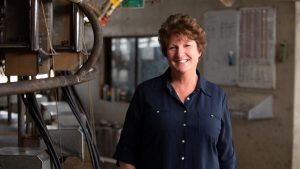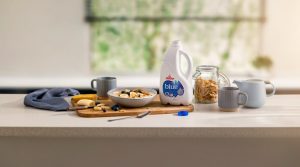
It was fun, filling your own bottle, dating it. But it also seemed a tiny step towards enlightenment – reducing plastic, saving water, supporting farmers, gentling cows. More so, now that I have cows and see what familial creatures they are. Yet milk may be – perhaps should be – on the way out.
The numbers are complex. In 1980, reports the ABC, Australia had 22,000 dairy farms. Now there are fewer than 6,000. True, this is due in part to consolidation and industrialisation. So the drop in farm numbers is partly offset by increased per-farm output (despite job losses) – but still, since deregulation in 1999-2000, Australia’s total milk production has dropped 15 per cent. Now, although relatively stable at around 9 billion-odd litres, it has shrunk from 16 per cent to 6 per cent of global production.
But the morality of milk is more complex still. On the one hand, milk is the ultimate in gustatory innocence. Symbolising both childhood and motherhood, it is the purest and wholest of pure wholefoods, its very whiteness and smoothness emphasising this nutritional probity. A young man who asks for a glass of milk seems straight away to qualify as daughter-boyfriend material.
On the other, milk is exploitative, cruel, unnatural, plastic-wrapped, wasteful of land and water and dramatically destructive of climate. It’s almost a purpose-designed object lesson in how our innocence itself becomes a form of hubris; how whiteness and purity so easily flip into the opposite of what they want to imply.
So the question becomes, which of milk’s destructive traits are inherent? And which just the spreading toxins of cut-price capitalism?
First, exploitation. Everywhere, dairy farmers are going out of business. One, a friend of a friend, is spending $10,000 a week on emergency feed to get his cows through the summer-from-hell. He cannot de-stock, as a normal farmer might, because should he default, he’ll never get a supply contract again.
This is cut-price capitalism at work. In February, to great acclaim, Woollies promised to raise its $1-a-litre milk price to $1.10 and pass the rise on to farmers; in March, Coles and Aldi followed. Although the price rise was less than inflation the farmers – rather sweetly I thought, given how many of them had already been forced to the wall – welcomed it as “a game changer”.
This week, my milk-price ground-truthing expedition showed both Woollies and Coles price-matching at $1.20 a litre, after raising prices again in July. Woollies even label theirs “drought relief milk”, assuring purchasers that “part of the proceeds of this milk go directly to farmers affected by drought”. But how much, if any?
In October dairy farmer Scott Priebbenow sent the last of his family’s dairy herd to the meatworks. He wiped away tears of rage as he told the ABC how the supermarkets – “you dirty rotten mongrel bastards” – had failed to pass the most recent price rise on to farmers. The supermarkets could have fixed it “just like that”. Priebbenow clicked his fingers. But now it’s too late. “Our cows are going to be hanging on a hook in a fridge.” And this month the ACCC alleged Coles did not pass on all of the first price rise to struggling dairy farmers.
It’s a lethal mix of contractual bastardry and human-exacerbated drought. But solutions are not obvious, since supermarkets and farmers each contract with the middle-men, the processors. Last year’s ACCC dairy inquiry – noting drily that collective bargaining is not always effective and that, milk being so terribly perishable, boycott often rebounds against farmers – suggested legal advice and a mandatory code of conduct.
But is this really the answer for an industry already deformed and debased by the massed buying power of the processors? Perhaps the biggest problem facing humans right now is how to feed ourselves without destroying either the planet or our own health. It doesn’t take a genius to see that basing our nutrition on the misery of other species is unlikely to be any better for our health than it is for our integrity.
So to the cruelty question. Is milk cruel? There are two ways in which this may be so – calf removal, and cow lifestyle.
Clearly, nature means cow’s milk not for us but for calves. This means both that our guts are not especially adapted to it and that, in drinking it, we’re depriving the rightful recipients. We could share. Calf-removal is not essential. Like human mothers, cows (if adequately nourished) easily produce more than enough for their own offspring.
But calf-removal is overwhelmingly the norm. Very soon after birth calves are taken and either killed, raised for veal or kept for milk production. Footage – the gathering of which is now illegal in Australia – clearly demonstrates how the mothers bellow in misery when their babies are removed.
There’s also everyday cruelty. Milk’s “innocence” relies on a fairytale image of an old widow with her single milk-cow, or Swiss maidens on grassy slopes, tresses thrown back and skirts tucked as they squeeze Daisy and Arabella’s swollen teats. So not.
Even the NSW Farmers’ website shows hundreds of cows regimented in steel pens on hoseable concrete floors, heads stuck through bars for feed. It’s not how cows should live. If you watch pastured cattle, as I now do, you see just what herd animals they are.
We’re always touched by how groups of elephants educate, nurture and protect each others’ offspring. Free-range cattle do likewise, the entire herd organising as family around the young.
Then there’s plastic. Cheap milk comes, almost exclusively, in plastic bottles whose tops are not recyclable, even in theory. And water use. Producing a glass of milk uses 12 times the water, 10 times the land and generates more than three times the greenhouse emissions of a glass of oat milk.
So. Have coconut yoghurt on your cereal (delicious), oat milk in your tea and, for a special treat, organic cow at $4 a litre; pay more, drink less. But know this, my friend. The days of ultra-cheap cow’s milk are, and should be, numbered.
























